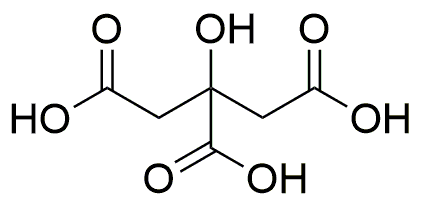Citric acid anhydrous is widely utilized in research focused on:
- Food and Beverage Industry: It serves as a natural preservative and flavor enhancer, helping to improve the taste and shelf-life of products such as soft drinks, candies, and sauces.
- Pharmaceuticals: Used as an excipient in drug formulations, it aids in stabilizing active ingredients and improving solubility, making medications more effective and easier to absorb.
- Cosmetics and Personal Care: Its properties as a pH adjuster and antioxidant make it a popular ingredient in skincare products, enhancing product stability and skin compatibility.
- Cleaning Products: Citric acid acts as a natural chelating agent, effectively removing limescale and mineral deposits, making it ideal for eco-friendly cleaning solutions.
- Biotechnology: In laboratory settings, it is used in buffer solutions for biochemical assays, providing a stable environment for enzyme reactions and other biological processes.
General Information
Properties
Safety and Regulations
Applications
Citric acid anhydrous is widely utilized in research focused on:
- Food and Beverage Industry: It serves as a natural preservative and flavor enhancer, helping to improve the taste and shelf-life of products such as soft drinks, candies, and sauces.
- Pharmaceuticals: Used as an excipient in drug formulations, it aids in stabilizing active ingredients and improving solubility, making medications more effective and easier to absorb.
- Cosmetics and Personal Care: Its properties as a pH adjuster and antioxidant make it a popular ingredient in skincare products, enhancing product stability and skin compatibility.
- Cleaning Products: Citric acid acts as a natural chelating agent, effectively removing limescale and mineral deposits, making it ideal for eco-friendly cleaning solutions.
- Biotechnology: In laboratory settings, it is used in buffer solutions for biochemical assays, providing a stable environment for enzyme reactions and other biological processes.
Documents
Safety Data Sheets (SDS)
The SDS provides comprehensive safety information on handling, storage, and disposal of the product.
Product Specification (PS)
The PS provides a comprehensive breakdown of the product’s properties, including chemical composition, physical state, purity, and storage requirements. It also details acceptable quality ranges and the product's intended applications.
Certificates of Analysis (COA)
Search for Certificates of Analysis (COA) by entering the products Lot Number. Lot and Batch Numbers can be found on a product’s label following the words ‘Lot’ or ‘Batch’.
*Catalog Number
*Lot Number
Certificates Of Origin (COO)
This COO confirms the country where the product was manufactured, and also details the materials and components used in it and whether it is derived from natural, synthetic, or other specific sources. This certificate may be required for customs, trade, and regulatory compliance.
*Catalog Number
*Lot Number
Safety Data Sheets (SDS)
The SDS provides comprehensive safety information on handling, storage, and disposal of the product.
DownloadProduct Specification (PS)
The PS provides a comprehensive breakdown of the product’s properties, including chemical composition, physical state, purity, and storage requirements. It also details acceptable quality ranges and the product's intended applications.
DownloadCertificates of Analysis (COA)
Search for Certificates of Analysis (COA) by entering the products Lot Number. Lot and Batch Numbers can be found on a product’s label following the words ‘Lot’ or ‘Batch’.
*Catalog Number
*Lot Number
Certificates Of Origin (COO)
This COO confirms the country where the product was manufactured, and also details the materials and components used in it and whether it is derived from natural, synthetic, or other specific sources. This certificate may be required for customs, trade, and regulatory compliance.


